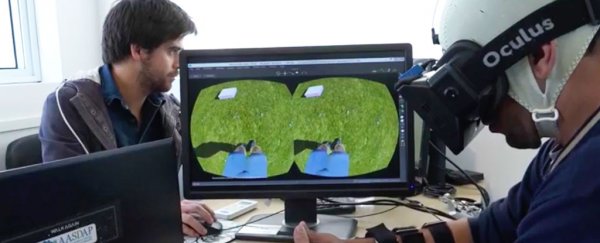Eight long-term paraplegics who were fully paralysed from the waist down have experienced a partial recovery after training with virtual reality (VR) and robotic technologies.
The first-of-its-kind rehab program, carried out by researchers in Brazil as part of the Walk Again Project, saw patients who had been paralysed for several years take their first steps post-injury – with one woman recovering movement after 13 years of paralysis.
The patients used what's called a brain-machine interface – a system that recorded their brain activity to detect thoughts associated with movement.
Those signals were first used to control VR avatars, before the patients progressed to brain-controlled robotics, including using exoskeletons to help them take physical steps.
"We couldn't have predicted this surprising clinical outcome when we began the project," said lead neuroscientist Miguel Nicolelis from Duke University's Centre for Neuroengineering.

"What we're showing in this paper is that patients who used a brain-machine interface for a long period of time experienced improvements in motor behaviour, tactile sensations and visceral functions below the level of the spinal cord injury. Until now, nobody has seen recovery of these functions in a patient so many years after being diagnosed with complete paralysis."
We've heard of amazing recoveries or partial recoveries in people with paralysis before, but most of these involve surgical procedures that implant devices like computer chips or bionic spines that help them regain movement with their thoughts.
By contrast, Nicolelis's approach is totally non-invasive, and suggests that long-term training with external devices can in fact wake up nerves that have become inactive after accidents that cause paralysis.
"[A] large percentage of patients who are diagnosed as having complete paraplegia may still have some spinal nerves left intact," said Nicolelis. "These nerves may go quiet for many years because there is no signal from the cortex to the muscles. Over time, training with the brain-machine interface could have rekindled these nerves."
The patients in the study wore fitted caps lined with non-invasive electrodes that recorded brain activity through electroencephalography (EEG), which monitors electrical activity in the brain.
While wearing VR visors, the participants were asked to imagine walking through the virtual environment. At first, the EEG showed no activity in relation to such prompts.
"[T]he brain had almost completely erased the representation of their lower limbs," Nicolelis explains.
But after months of training, the leg movement signals started to show. "Basically, the training reinserted the representation of lower limbs into the patients' brains," he said.
After using the VR setups, the patients progressed to more challenging assisted-walking devices, including overhead harnesses and exoskeletons.
At the beginning of the training, five of the patients had been paralysed for at least five years, and two had been paralysed for more than a decade. After a year in the program, in which participants trained for at least 2 hours a week with the brain-machine interfaces, four of the patients had regained enough movement and sensation that doctors upgraded their diagnoses from complete to partial paralysis.
In addition to recovering movement, the participants experienced other health benefits due to the rehabilitation, including improvements in bladder control and bowel function, which lower risk of infection – a leading cause of death in patients with chronic paralysis, says Nicolelis.
Men in the group experienced improved sexual performance, and one of the women even decided to have a baby after recovering partial sensations in the lower part of her body, which resulted in her feeling the contractions during delivery.
The findings have been published in Scientific Reports, but the researchers aren't finished yet. They intend to conduct follow-up studies on the eight patients – who have now exceeded two years of training – to see how they progress with further treatment.
They also want to see whether training with paraplegics who haven't been paralysed for as long could lead to faster or better results.
But already this research will have given new hope to many people around the world who experience paralysis, and we can't wait to find out what the scientists discover next.
Find out more about the study in the video below:
